Magnetism and Electromagnetism
Natural and artificial magnets
Among the iron ores mined for the metallurgical industry is an ore called magnetic iron ore. This ore has the property of attracting iron objects to itself.
A piece of such iron ore is called a natural magnet, and the property of attraction it exhibits is magnetism.
Nowadays, the phenomenon of magnetism is used extremely widely in various electrical installations. However, now they use not natural, but so-called artificial magnets.
Artificial magnets are made of special steels. A piece of such steel is magnetized in a special way, after which it acquires magnetic properties, that is, it becomes permanent magnet.
The shape of permanent magnets can be very diverse, depending on their purpose.
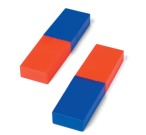 In a permanent magnet, only its poles have gravitational forces. The north-facing end of the magnet is agreed to be called the north pole magnet, and the south-facing end is the south pole magnet. Every permanent magnet has two poles: north and south. The north pole of a magnet is indicated by the letter C or N, the south pole by the letter Yu or S.
In a permanent magnet, only its poles have gravitational forces. The north-facing end of the magnet is agreed to be called the north pole magnet, and the south-facing end is the south pole magnet. Every permanent magnet has two poles: north and south. The north pole of a magnet is indicated by the letter C or N, the south pole by the letter Yu or S.
The magnet attracts iron, steel, cast iron, nickel, cobalt to itself. All these bodies are called magnetic bodies. All other bodies that are not attracted by a magnet are called non-magnetic bodies.
The structure of the magnet. Magnetization
Every body, including the magnetic one, consists of the smallest particles - molecules. Unlike the molecules of non-magnetic bodies, the molecules of a magnetic body have magnetic properties, representing molecular magnets. Inside a magnetic body, these molecular magnets are arranged with their axes in different directions, with the result that the body itself does not exhibit any magnetic properties. But if these magnets are forced to rotate about their axes so that their north poles turn in one direction and their south poles in the other, then the body will acquire magnetic properties, that is, it will become a magnet.
The process by which a magnetic body acquires the properties of a magnet is called magnetization... In the production of permanent magnets, magnetization is carried out with the help of an electric current. But you can magnetize the body in another way, using an ordinary permanent magnet.
If a rectilinear magnet is cut along a neutral line, then two independent magnets will be obtained, and the polarity of the ends of the magnet will be preserved, and opposite poles will appear at the ends obtained as a result of cutting.
Each of the resulting magnets can also be divided into two magnets, and no matter how much we continue this division, we will always get independent magnets with two poles. It is impossible to obtain a bar with one magnetic pole. This example confirms the position that the magnetic body consists of many molecular magnets.
Magnetic bodies differ from each other in the degree of mobility of the molecular magnets. There are bodies that are quickly magnetized and just as quickly demagnetized. Conversely, there are bodies that magnetize slowly but retain their magnetic properties for a long time.
So iron is quickly magnetized under the action of an external magnet, but just as quickly demagnetized, that is, it loses its magnetic properties when the magnet is removed. Steel, after being magnetized, retains its magnetic properties for a long time, that is, it becomes a permanent magnet.
The property of iron to quickly magnetize and demagnetize is explained by the fact that the molecular magnets of iron are extremely mobile, they easily rotate under the influence of external magnetic forces, but just as quickly return to their previous disordered position when the magnetizing body is removed .
In iron, however, a small proportion of the magnets, and after the removal of the permanent magnet, still remain for some time in the position which they occupied at the time of magnetization. Therefore, after magnetization, iron retains very weak magnetic properties. This is confirmed by the fact that when the iron plate was removed from the pole of the magnet, not all the sawdust fell from its end — a small part of it remained attracted to the plate.
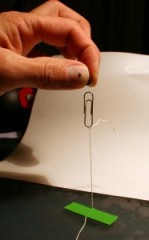 The property of steel to remain magnetized for a long time is explained by the fact that the molecular magnets of steel hardly rotate in the desired direction during magnetization, but they retain their stable position for a long time even after the removal of the magnetizing body.
The property of steel to remain magnetized for a long time is explained by the fact that the molecular magnets of steel hardly rotate in the desired direction during magnetization, but they retain their stable position for a long time even after the removal of the magnetizing body.
The ability of a magnetic body to exhibit magnetic properties after magnetization is called residual magnetism.
The phenomenon of residual magnetism is caused by the fact that in a magnetic body there is a so-called retarding force that keeps the molecular magnets in the position they occupy during magnetization.
In iron, the action of the retarding force is very weak, with the result that it quickly demagnetizes and has very little residual magnetism.
The property of iron to quickly magnetize and demagnetize is extremely widely used in electrical engineering. Suffice it to say that the cores of each electromagnetsthose used in electrical devices are made of special iron with extremely low residual magnetism.
Steel has a great holding power, due to which the property of magnetism is preserved in it. that's why permanent magnets are made of special steel alloys.
The properties of permanent magnets are adversely affected by shock, impact and sudden temperature fluctuations. If, for example, a permanent magnet is heated to red and then allowed to cool, then it will completely lose its magnetic properties. Likewise, if you subject a permanent magnet to shocks, then its force of attraction will significantly decrease.
This is explained by the fact that with strong heating or shocks, the action of a retarding force is overcome and thus the orderly arrangement of the molecular magnets is disturbed. Therefore, permanent magnets and permanent magnet devices must be handled with care.
Magnetic lines of force. Interaction of the poles of magnets
Around each magnet there is a so-called magnetic field.
A magnetic field is called the space in which magnetic forces... The magnetic field of a permanent magnet is that part of space in which the fields of a rectilinear magnet and the magnetic forces of this magnet act.
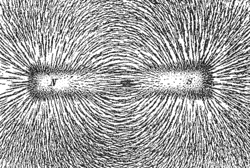
The magnetic forces of the magnetic field act in certain directions... The directions of action of the magnetic forces agreed to be called magnetic lines of force... This term is widely used in the study of electrical engineering, but it must be remembered that magnetic lines of force are not material: this is a conventional term introduced only to facilitate the understanding of magnetic field properties.
The shape of the magnetic field, that is, the location of the magnetic field lines in space depends on the shape of the magnet itself.
Magnetic field lines have a number of properties: they are always closed, never cross, tend to take the shortest path, and repel each other if they are pointing in the same direction. It is generally accepted that lines of force exit from the north pole of the magnet and enter its south pole; inside the magnet, they have a direction from the south pole to the north.
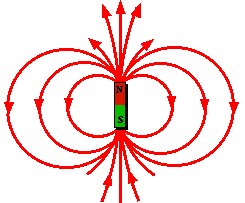
Like magnetic poles repel, unlike magnetic poles attract.
It is easy to convince yourself of the correctness of both conclusions in practice. Take a compass and bring to it one of the poles of a rectilinear magnet, for example, the north pole. You will see that the arrow will instantly turn its south end to the north pole of the magnet. If you quickly turn the magnet 180 °, then the magnetic needle will immediately turn 180 °, that is, its north end will face the south pole of the magnet.
Magnetic induction. Magnetic flux
The force of action (attraction) of a permanent magnet on a magnetic body decreases as the distance between the pole of the magnet and this body increases. A magnet exhibits the greatest force of attraction directly at its poles, that is, exactly where the magnetic force lines are most densely located. Moving away from the pole, the density of the lines of force decreases, they are found more and more rarely, along with this, the attraction force of the magnet also weakens.
Thus, the force of attraction of a magnet at different points of the magnetic field is not the same and is characterized by the density of the lines of force. To characterize the magnetic field at its various points, a quantity called magnetic field induction is introduced.
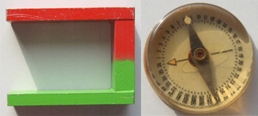
The magnetic induction of the field is numerically equal to the number of lines of force passing through an area of 1 cm2, located perpendicular to their direction.
This means that the greater the density of field lines at a given point in the field, the greater the magnetic induction at that point.
The total number of magnetic lines of force passing through any region is called the magnetic flux.
Magnetic flux is denoted by the letter F and is related to magnetic induction through the following relationship:
Ф = BS,
where F is the magnetic flux, V is the magnetic induction of the field; S is the area penetrated by a given magnetic flux.
This formula is valid only if the area S is perpendicular to the direction of the magnetic flux. Otherwise, the magnitude of the magnetic flux will also depend on the angle at which the area S is located, and then the formula will take on a more complex form.
The magnetic flux of a permanent magnet is determined by the total number of lines of force passing through the cross section of the magnet.The greater the magnetic flux of a permanent magnet, the more attractive that magnet is.
The magnetic flux of a permanent magnet depends on the quality of the steel from which the magnet is made, the size of the magnet itself and the degree of its magnetization.
Magnetic permeability
The property of a body to allow magnetic flux through itself is called magnetic permeability... It is easier for magnetic flux to pass through air than through a non-magnetic body.
To be able to compare different substances according to their magnetic permeability, it is customary to consider the magnetic permeability of air to be equal to unity.
They are called substances with magnetic permeability less than unity diamagnetic... They include copper, lead, silver, etc.
Aluminum, platinum, tin, etc. They have a magnetic permeability slightly greater than unity and are called paramagnetic substances.
Substances with a magnetic permeability much greater than one (measured in thousands) are called ferromagnetic. These include nickel, cobalt, steel, iron, etc. All types of magnetic and electromagnetic devices and parts of various electrical machines are produced from these substances and their alloys.
Of practical interest for communication technologies are special iron-nickel alloys called permaloid.
